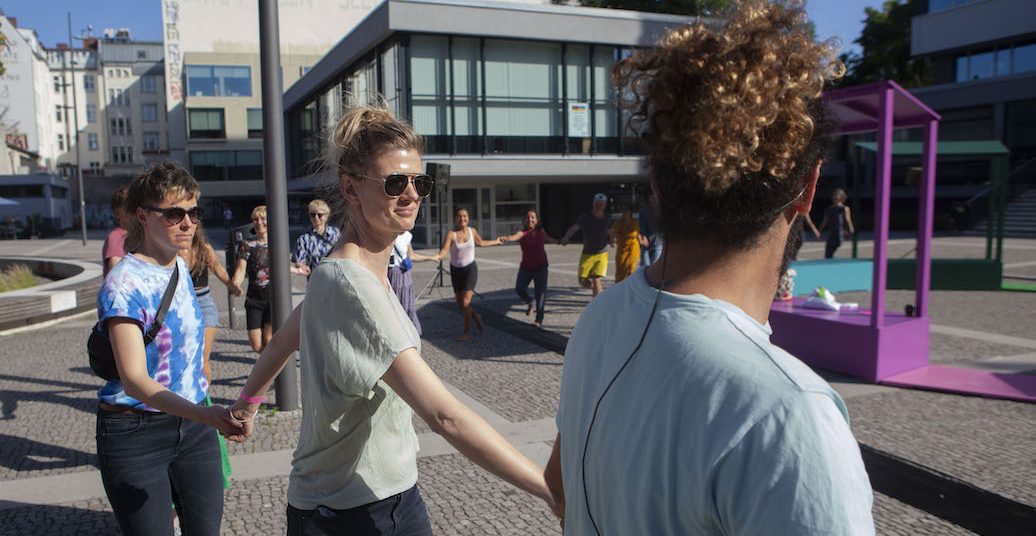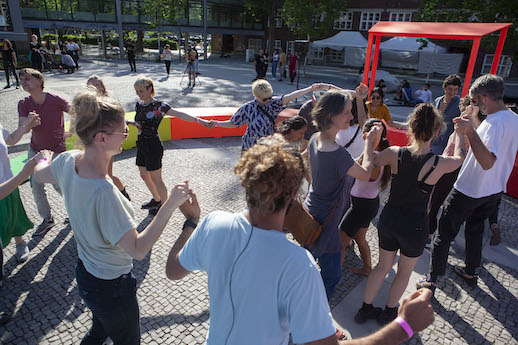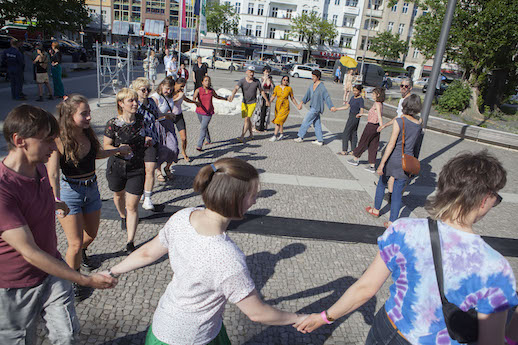Set up by Galerie Wedding – Raum für Zeitgenössische Kunst, as part of Movement Research ACROSS, the “Flexible Colour Circle”, an inhabitable outdoor stage, offered a space for performances and encounters over two extended weekends in June. “Dabke Community Dancing” by Medhat Aldaabal and Adel Sabawi, presented by Sasha Waltz & Guests and Berlin Mondiale, was part of the curation at this site.
Question: What happens when a circular thing is erected in a flat, square place?
Hypothesis: A circular thing in a square place makes people slow down, congregate, pause, and breathe together.
Reasoning: The “Flexible Colour Circle” was installed at the Rathausvorplatz, that is, the square in front of the Rathaus (town hall) in Wedding. There I observed how it was a site of congregation, that allowed not only for pause, but also gave reasons to move.
————————————
Just like on any other day, there is a constant flow of people moving through and around the Wedding Rathausvorplatz. Some cross between the weekly markets, while others rush to the U-Bahn station at Leopoldplatz. When I arrive, many of those who presumably have unfinished bureaucratic pursuits at the Rathaus and the Job Center are still ambling around like hopeful honey bees. As I join the sea of people strolling down Müllerstraße, I momentarily panic about being unable to find the correct location in time for the dabke workshop with Medhat Aldaabal. But the Flexible Colour Circle, an installation designed by visual artist Viron Erol Vert, is unmistakable and eye-catching with its rainbow of vibrant colours. I gravitate towards it as Aldaabal is beginning the workshop.
Inside the Flexible Colour Circle, Aldaabal invites all the participants to stand in a circle as he leads us through a warm up. Next, he asks us to hold hands with those on either side of us. This act of holding a stranger’s hands feels so old and yet so new after the COVID19 pandemic and marks the beginning of our foray into dabke. Aldaabal teaches us the basic six-step footwork of dabke, a Levantine folk dance form, breaking it down to its simplest elements. I look around at the circle of those who are gathered. Some are artists I have seen around at other Berlin events, but many seem to be incidental passers-by. Throughout the next hour, others join in spontaneously join in. The hands in the circle always unlink to make space for the newcomer.
My attention returns to Aldaabal, our teacher for the hour. Every sequence of the basic six-step footwork of dabke moves the dancers anticlockwise around the circle. Aldaabal gradually adds small variations in the footwork, adding to its complexity. As we practice our first four basic foot shuffles, Aldaabal leads us outside the Flexible Colour Circle. Our loopy and curving line winds around the square, making us look up from our feet and at the bemused expressions of those crossing the square. Some of them stop to watch us. We are clearly not yet experts and I suppose we make a curious group. By now our circle is made up of people of different age groups, diverse builds, and cuts across gender spectrums. On the faces of the dancers, I see laughter, silliness, and nervous confusion, often accompanied by giggles, most likely an inevitable by-product of learning this boisterous dance form.
After snaking around the plaza, we return to the open confines of the Flexible Colour Circle. I look around at Vert’s design that is made up of twelve colours — the primary, secondary, and complimentary colours arranged as per Johannes Itten’s chromatic circle. While the programme notes mention that the installation is inspired by artist Emily Noyes Vanderpoel’s colour charts and studying the imaginary effects of colour and Goethe’s theory of colour, my eyes are only able to identify them as the familiar basic colours of Microsoft Paint from my childhood days. Perhaps it is this child-like simplicity that draws passers-by to the installation. Luckily, this is an art installation one is allowed to touch, that you can sit on, stand on, and even stamp on. And, so the passers-by stay. Sometimes, they join our group of dabke learners.
Certainly, there are also those who don’t join in. There are Wedding residents that may not find resonance with the offerings of the inceasingly gentrified spaces on this very street. I meet Solvej Helweg Ovesen, one of the curators of Movement Research ACROSS, inside the gallery later to ask about their team’s decision to place themselves in this site outside Galerie Wedding. Ovesen tells me that their purpose with programming such as this is to enable “movement to stir social isolation, and to make all kinds of spectatorship possible, accessible and safe”. I appraise her words, and wonder what this new dramatic addition does to the social site. This ‘circle’ is, in fact, a 12-sided polygon. Each side of the polygon forms a separate section that is a unique colour and is shaped differently from each of the other sections. Some are flat panels on the floor, some are raised sections at a height comfortable for sitting, while other raised sections have roofs supported by pillars at four corners. The overall effect of this circle, then, is of being on a veranda. A veranda is a liminal space between the inside and out, a space that allows a view into the world while providing the notion of an impermeable boundary. Similarly, Vert’s flexible circle offers one the possibility of looking into the circle while remaining at its edge. The panels lying flat along the floor and at seat height allow one to simply step into the circle if one wishes to. Those who choose to remain outside, however, are also included by sight and sound. As in some amphitheatres, there is no fixed front or back and the space within the circle offers the possibility of a stage. Even so, the energies of the colours pull one’s eyes outwards and along the edges of the circle, decentralising the idea of a singular performance space. When placed at the Rathausvorplatz in Wedding, this permeable inhabitable stage creates an uncanny shift in the public space. This circle creates a new site of congregation in what is largely a place for crossing. During the break I lay on the blue panel of Vert’s installation and in this moment, after congregation, it has become a place to recline, a site of rest.
Pictures: Dabke Community Dance Workshop with Medhat Aldaabal and Adel Sabawi at Rathausvorplatz (Town Hall Square), Berlin-Wedding as part of Movement Research ACROSS, June 2022 ©XO Curatorial Projects, photos by Juan Saez.
Since 2017, choreographer Medhat Aldaabal has been teaching dabke to Berliners in a format he co-created with musicians Ali Hasan and Adel Sabawi. What we are exploring today is Dabke Choubi, a style that is commonly known in Syria, Palestine, Lebanon and Jordan. “What does it take to teach a folk dance form that one usually only learns by watching others dance it at weddings and gatherings?” I ask Aldaabal later on a phone call. He shares that the process has required him to impose a kind of order, create a repertoire, and then transmit a cumulative logic in order to teach the form. At the same time, he likes to encourage experienced participants by offering enough variations to experiment with. This makes the steps accessible to people with different levels of comfort with dance movement. Importantly, he says, he has renounced any attachment to any idea of how dabke is supposed to be, encouraging workshop participants to add their creativity and make it their own.
At the Flexible Colour Circle, the time has come! On cue to the electric guitar riffs by Adel Sabawi, each participant leads the rest of the curving line on a dabke odyssey inside Vert’s installation and around the Rathausvorplatz. As each person takes the lead, their personal interpretation of dabke morphs into something that brings in resonances from other dance forms and registers that sit in their bodies. Here I spy a little bit of bachata, and in another moment, someone goes up on their toes, imitating ballet. As for me, I make sure to put in some bhangra in here. The others down the line support the leader by doing our best to keep up with the beat. Although, actually, we frequently miss the beat and mix up the step variations we learnt in the last one hour, at this moment, we are all dabke stars.
Dabke Community Dance Workshops are run by Medhat Aldaabal and accompanied musically by Ali Hasan and Adel Sabawi.
Movement Research ACROSS with Viron Erol Vert’s Flexible Colour Circle runs until 30 July 2022 at Rathausvorplatz & Galerie Wedding – Space for Contemporary Art. Read here “Parade parallel” (12 June 2022, in German only) by tanzschreiber author Janine Muckermann about Rachel Monosov’s dance performance “Landscape of Comfort,” a festive parade with pedal scooters, also shown in the framework of of Movement Research ACROSS.







